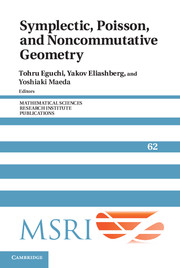Book contents
- Frontmatter
- Contents
- Preface
- Flexible Weinstein manifolds
- The Hirzebruch–Riemann–Roch Theorem in true genus-0 quantum K-theory
- On some deformations of Fukaya categories
- Morphisms of CohFT algebras and quantization of the Kirwan map
- Deformation of expressions for elements of an algebra
- Microlocal theory of sheaves in symplectic topology
- Algebra + homotopy = operad
Morphisms of CohFT algebras and quantization of the Kirwan map
Published online by Cambridge University Press: 25 June 2025
- Frontmatter
- Contents
- Preface
- Flexible Weinstein manifolds
- The Hirzebruch–Riemann–Roch Theorem in true genus-0 quantum K-theory
- On some deformations of Fukaya categories
- Morphisms of CohFT algebras and quantization of the Kirwan map
- Deformation of expressions for elements of an algebra
- Microlocal theory of sheaves in symplectic topology
- Algebra + homotopy = operad
Summary
We introduce a notion of morphism of CohFT algebras, based on the analogy with A∞ morphisms. We outline the construction of a “quantization” of the classical Kirwan morphism to a morphism of CohFT algebras from the equivariant quantum cohomology of a G-variety to the quantum cohomology of its geometric invariant theory or symplectic quotient, and an example relating to the orbifold quantum cohomology of a compact toric orbifold. Finally we identify the space of Cartier divisors in the moduli space of scaled marked curves; these appear in the splitting axiom.
1. Introduction
In order to formalize the algebraic structure of Gromov–Witten theory Kontsevich and Manin introduced a notion of cohomological field theory (CohFT); see [Manin 1999, Section IV]. The correlators of such a theory depend on the choice of cohomological classes on the moduli space of stable marked curves and satisfy a splitting axiom for each boundary divisor. In genus zero the moduli space of stable marked curves may be viewed as the complexification of Stasheff's associahedron from [Stasheff 1970], and the notion of CohFT may be related to the notion of A∞-algebra: dualizing one of the factors gives rise to a collection of multilinear maps that we call a CohFT algebra. The full CohFT is related to the CohFT algebra in the same way that a Frobenius algebra is related to the underlying algebra. Recall that Dubrovin [1996] constructed from any CohFT a Frobenius manifold, which is a manifold with a family of multiplications on its tangent spaces together with some additional data.
Information
- Type
- Chapter
- Information
- Symplectic, Poisson, and Noncommutative Geometry , pp. 131 - 170Publisher: Cambridge University PressPrint publication year: 2014
Accessibility standard: Unknown
- 1
- Cited by
